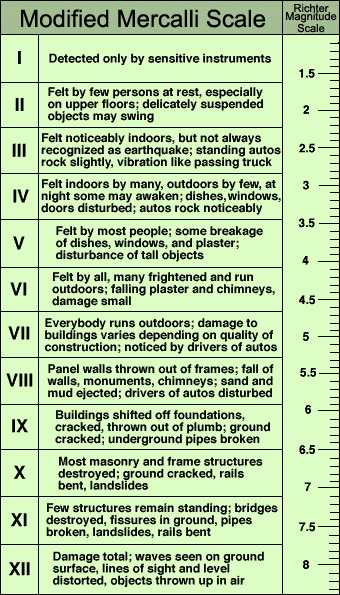The “size” of earthquakes is commonly expressed in two ways- magnitude and intensity.
Magnitude is a measure of the total energy released during an earthquake. It is determined from a seismogram, which plots the ground motion produced by seismic waves. As devised by C.F. Richter in 1935, the magnitude scale allows us to compare earthquakes in relative terms.
Though the term is used somewhat indiscriminately, magnitude is a highly technical calculation. Magnitude is defined as the logarithm (1 micron =.0001 centimeter), as would be recorded by a standard short-period seismograph with specific constants, at an epicentral distance of 100 kilometers (62 miles).
The important thing to remember about magnitude is that the scale is logarithmic, which means that each step in magnitude represents a tenfold increase in amplitude of wave motion. Therefore, an earthquake of magnitude 6.0 has 10 times the wave amplitude of an earthquake of magnitude 5.0, 100 times the wave amplitude of a magnitude 4.0 earthquake, and 1,000 times the wave amplitude of a magnitude 3.0 earthquake.
Because magnitude does not describe the extent of the damage, its usefulness is limited to an approximation of whether the earthquake is large, small, or medium-sized. The destructiveness of an earthquake is a complex matter, related to the geology, population density, and cultural features of a specific area at a specific distance from the epicenter.
Seismologists and geologists also describe earthquakes by their intensity. Measured on a numerical scale, intensity is the degree of damage or observable effects caused by an earthquake at a particular location. An earthquake of a particular magnitude will produce different intensities at different places, according to geology, population density, cultural features, and distance from the epicenter.
The most widely used intensity scale, the Modified Mercalli Scale, is divided into 12 degrees, each identified by a Roman numeral. For example, an earthquake intense enough to be felt by a person standing nearby is said to have an intensity of MM III.

